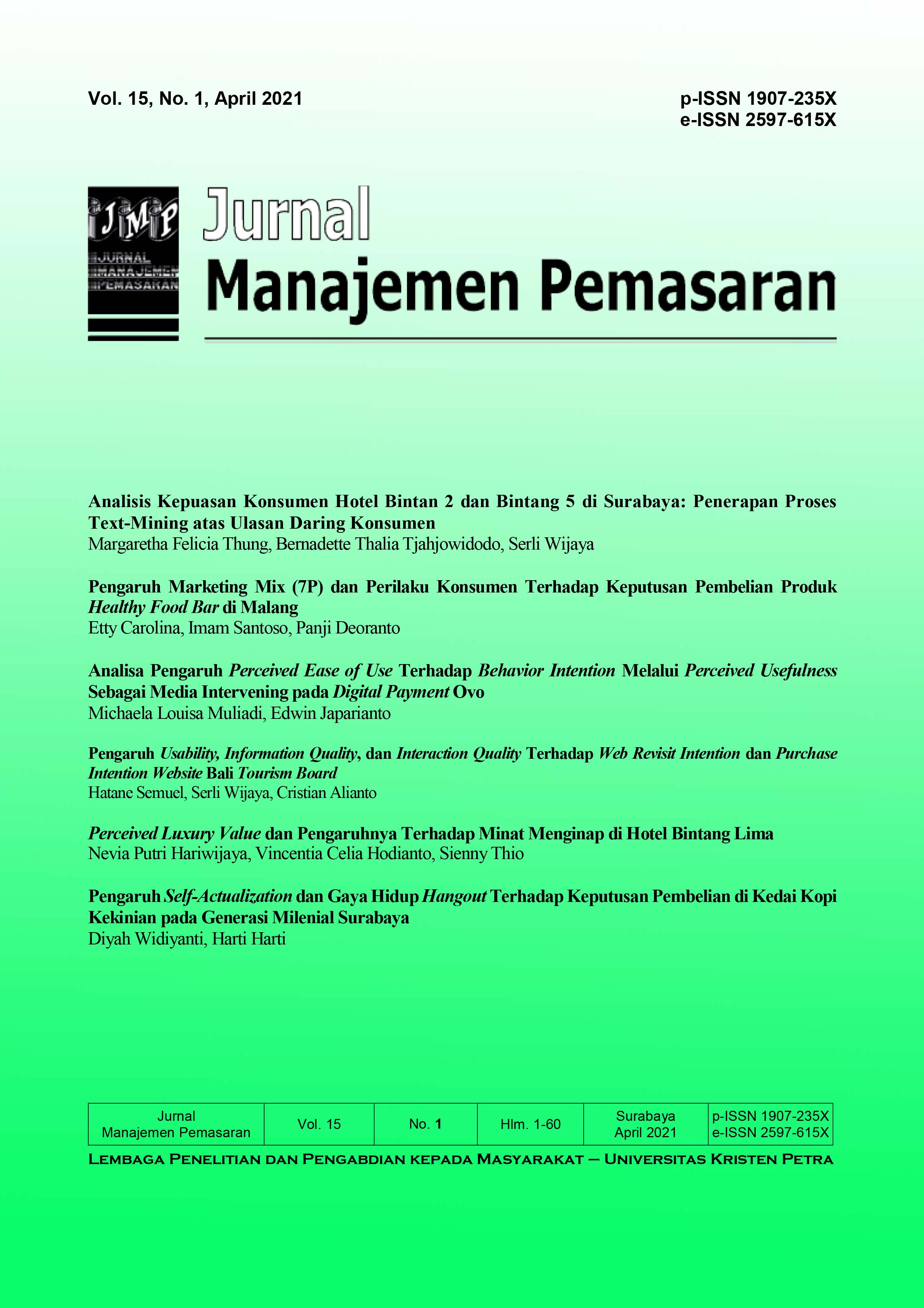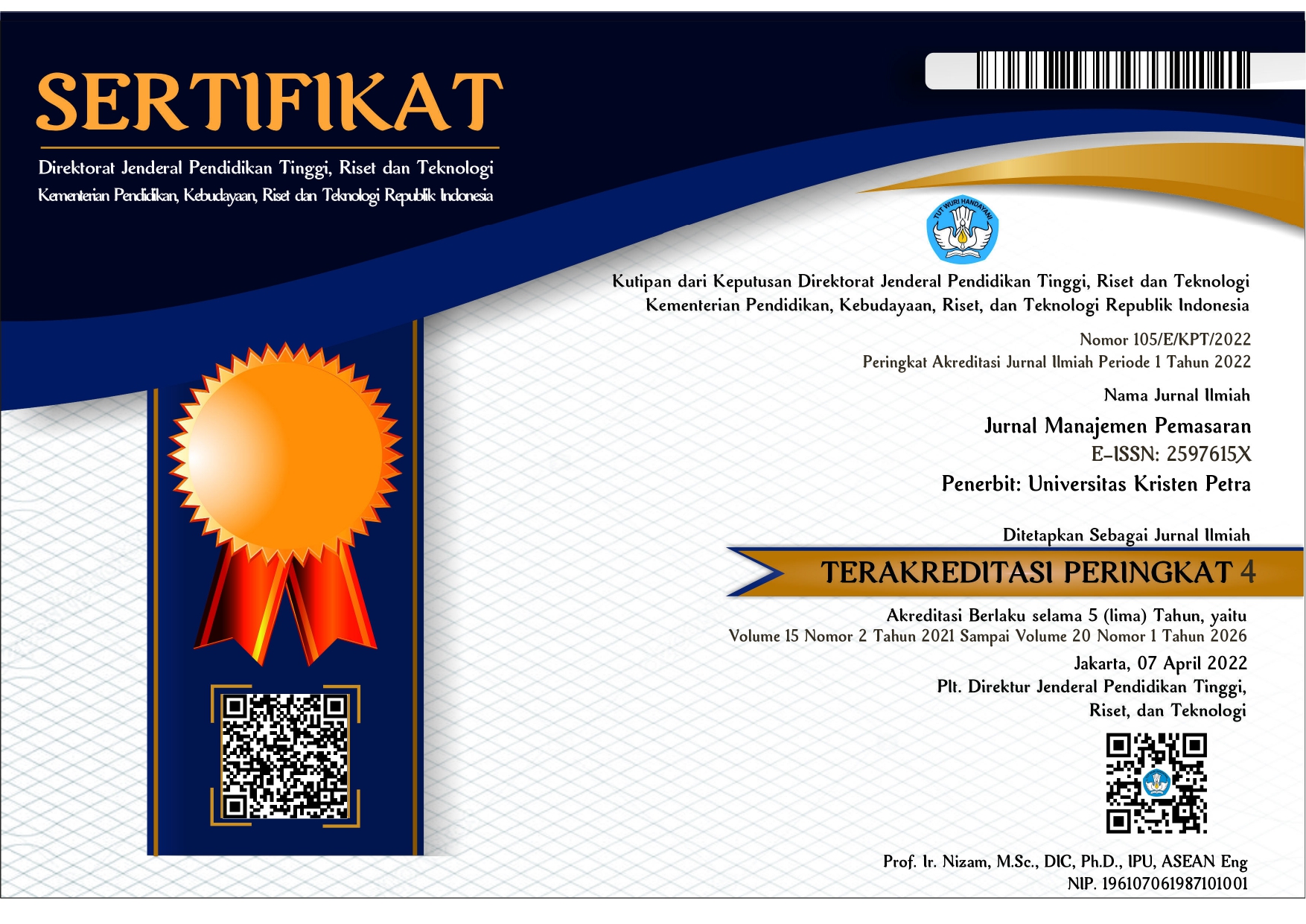PURCHASE INTENTION OF FASHION PRODUCT AS AN IMPACT OF DIGITAL MARKETING, MEDIATED BY CUSTOMER ENGAGEMENT IN THE GENERATION Z
 :
:
https://doi.org/10.9744/pemasaran.14.2.61-66
Keywords:
Generation Z, digital marketing, customer engagement, purchase intentionAbstract
This research is to study the impact of digital marketing on consumer engagement and purchase intention, consumer engagement on purchase intention, and the mediating effect of consumer engagement in the relation between digital marketing and purchase intention. The population in this research was generation Z. Samples were 236 students in two private universities in Surabaya. Data were analyzed with Andrew Hayes PROCESS model 4. The results show that all hypotheses were supported. The findings of this research contribute to the online communication strategy of online shop owners to reach generation ZReferences
Ariker, Ç., & Toksoy, A. (2017). Generation Z and CSR: Antecedents of purchasing intention of university students. KAUJEASF, 8(16), 483–502. https://doi.org/10.9775/kauiibfd.2017.023.
Bartholomew, D. (2013). A New Framework for Soci-al Media Metrics and Measurement. Metrics-man. https://metricsman.wordpress.com/2013/ 06/12/a-new-framework-for-social-media-metrics-and-measurement
Bassiouni, D. H., & Hackley, C. (2014). “Generation Z” children’s adaptation to digital consumer culture: A critical literature review. Journal of Customer Behaviour, 13(2), 113–133. https://doi. org/10.1362/147539214x14024779483591
Brodie, R. J., Hollebeek, L. D., Jurić, B., & Ilić, A. (2011). Customer engagement: Conceptual do-main, fundamental propositions, and implications for research. Journal of Service Research, 14(3), 252–271. https://doi.org/10.1177/10946705114 11703
Deloitte Indonesia. (2019, September). Generasi milenial dalam industri 4.0: berkah bagi sumber daya manusia Indonesia atau ancaman. Deloitte Indonesia Perspectives. https://www2.deloitte. com/content/dam/Deloitte/id/Documents/about-deloitte/id-about-dip-edition-1-chapter-2-id-sep2019.pdf
Dimock, M. (2019). Defining generations: Where millennials end and generation Z begins. Pew Research Center, 1996(1), 1–7. https://pewrsr. ch/3cV5pmw
Eom, H. J., & Seock, Y.-K. (2017). Purchase intention toward luxury fashion brands from the social comparison perspective: An extended abstract. In Marketing at the Confluence between Enter-tainment and Analytics: Proceedings of the 2016 Academy of Marketing Science (AMS) World Marketing Congress (pp. 1277–1280). https://doi. org/10.1007/978-3-319-47331-4_247
Gazzola, P., Pavione, E., Pezzetti, R., & Grechi, D. (2020). Trends in the fashion industry. The per-ception of sustainability and circular economy: A gender/generation quantitative approach. Sustai-na¬bility (Switzerland), 12(7), 1–19. https://doi. org/10.3390/su12072809
Goh, E., & Lee, C. (2018). A workforce to be reckoned with: The emerging pivotal Generation Z hos¬pitality workforce. International Journal of Hos¬pitality Management, 73, 20–28. https://doi.org/ 10.1016/j.ijhm.2018.01.016
Hair Jr, J. F., Black, W. C., Babin, B. J., & Anderson, R. E. (2014). Multivariate data analysis. In Explo-ratory Data Analysis in Business and Economics (Seventh Ed). Pearson Education Limited. https://doi.org/10.1007/978-3-319-01517-0_3
Harrigan, P., Evers, U., Miles, M. P., & Daly, T. (2018). Customer engagement and the relation¬ship between involvement, engagement, self-brand connection and brand usage intent. Journal of Business Research, 88, 388–396. https://doi. org/ 10.1016/j.jbusres.2017.11.046
Hayes, A. F. (2013). Model templates for PROCESS for SPSS and SAS. In Model Templates for PROCESS for SPSS and SAS. https://doi.org/ http://afhayes.com/public/templates.pdf
Hayes, A. F. (2015). An index and test of linear moderated mediation. Multivariate Behavioral Research, 50(1). https://doi.org/10.1080/002731 71.2014.962683
Hayes, A. F. (2018). Introduction to mediation, mode-ration, and conditional process analysis: A re-gres¬¬sion-based approach (2nd New Ed, p. 692). Guilford Publications.
Hollebeek, L. D. (2011). Demystifying customer brand engagement: Exploring the loyalty nexus. Jour¬nal of Marketing Management, 27(7–8), 785–807. https://doi.org/10.1080/0267257X.2010.50 0132
Hollebeek, L. D., & Macky, K. (2019). Digital content marketing’s role in fostering consumer engage-ment, trust, and value: Framework, fundamental propositions, and implications. Journal of Inter-active Marketing, 45, 27–41. https://doi.org/10. 1016/j.intmar.2018.07.003
Ištvanić, M., Milić, D. C., & Krpić, Z. (2017). Digital marketing in the business environment. Inter-national Journal of Electrical and Computer Engineering Systems, 8(2), 67–75. https://doi. org/10.32985/ijeces.8.2.4
Jackson, G., & Ahuja, V. (2016). Dawn of the digital age and the evolution of the marketing mix. Journal of Direct, Data and Digital Marketing Practice, 17(3), 170–186. https://doi.org/10. 1057/dddmp.2016.3.
Jacuński, M. (2018). Measuring and analysis of digital marketing. In Big Data, Digital Marketing and Trendwatching (Issue November, pp. 11–27). Oficyna Wydawnicza ATUT – Wrocławskie Wydawnictwo Oświatowe. https://doi.org/10. 23817/2018.bdata-1.
Key, T. M. (2017). Domains of digital marketing channels in the sharing economy. Journal of Mar¬keting Channels, 24(1–2), 27–38. https://doi. org/10.1080/1046669X.2017.1346977.
Kim, J. (2019). Luxury fashion goods ownership and collecting behavior in an omni-channel retail environment: Empirical findings from affluent consumers in the US. Research Journal of Textile and Apparel, 23(3), 212–231. https://doi.org/ 10.1108/RJTA-01-2019-0001.
Lauring, K., & Steenburg, E. Van. (2019). What drives young shoppers? Comparing millennial and generation Z online consumer behavior. 2019 Summer AMA Proceedings, August. https://www. researchgate.net/publication/333999262_What_Drives_Young_Shoppers_Comparing_Millennial_and_Generation_Z_Online_Consumer_Behavior.
Mulyani, Aryanto, R., & Chang, A. (2019). Under-standing digital consumer: Generation Z online shopping prefences. International Journal of Recent Technology and Engineering, 8(2), 925–929. https://doi.org/10.35940/ijrte.B1721.078219.
Okros, A. (2020). Generational theory and cohort analysis. In Harnessing the Potential of Digital Post-Millennials in the Future Workplace (pp. 33–51). Springer International Publishing. https://doi.org/10.1007/978-3-030-25726-2_2.
Paakkari, A. (2016). Customer journey of generation Z in fashion purchases [Lahti University of Applied Sciences Ltd]. https://core.ac.uk/download/pdf/ 80993038.pdf.
Priporas, C. V., Stylos, N., & Fotiadis, A. K. (2017). Generation Z consumers’ expectations of inter-actions in smart retailing: A future agenda. Computers in Human Behavior, 77, 374–381. https://doi.org/10.1016/j.chb.2017.01.058.
Roy, G., Datta, B., & Mukherjee, S. (2019). Role of electronic word-of-mouth content and valence in influencing online purchase behavior. Journal of Marketing Communications, 25(6), 661–684. https://doi.org/10.1080/13527266.2018.1497681
Schlosser, A. E., White, T. B., & Lloyd, S. M. (2006). Converting web site visitors into buyers: How web site investment increases consumer trusting beliefs and online purchase intentions. Journal of Marketing, 70(2), 133–148. https://doi.org/10. 1509/jmkg.70.2.133
Singh, A. (2014). Challenges and issues of generation Z. IOSR Journal of Business and Management, 16(7), 59–63. https://doi.org/10.9790/487x-1671 5963
Thangavel, P., Pathak, P., & Chandra, B. (2019). Consumer decision-making style of gen Z: A generational cohort analysis. Global Business Review, 1–19. https://doi.org/10.1177/0972150 919880128
Thomas, M. R., Kavya, V., & Monica, M. (2018). Online website cues influencing the purchase intention of generation Z mediated by trust. Indian Journal of Commerce & Management Studies, IX(1), 13. https://doi.org/10.18843/ ijcms/v9i1/03
Thomas, M. R., & Mathew, J. (2018). Online merchandising cues influencing the purchase intention of generation Z mediated by emotions using S-O-R framework. Asian Journal of Management, 9(1), 175. https://doi.org/10.5958/ 2321-5763.2018.00027.6
Toor, A., Husnain, M., & Hussain, T. (2017). The impact of social network marketing on consumer purchase intention in Pakistan: Consumer enga-gement as a mediator. Asian Journal of Business and Accounting, 10(1), 167–199. https://doi.org/ 10.5267/j.msl.2019.3.015
Vieira, V. A., de Almeida, M. I. S., Agnihotri, R., da Silva, N. S. D. A. C., & Arunachalam, S. (2019). In pursuit of an effective B2B digital marketing strategy in an emerging market. Journal of the Academy of Marketing Science, 47(6), 1085–1108. https://doi.org/10.1007/s1174701900687-1
Williams, A. (2015, September 18). Move Over, Millennials, Here Comes Generation Z [online]. New York Times. http://www.nytimes.com/2015/ 09/20/fashion/moveovermillennialsherecomesgenerationz.html?_r=0http://nyti.ms/1UZIA01.
















